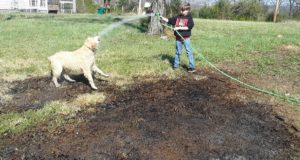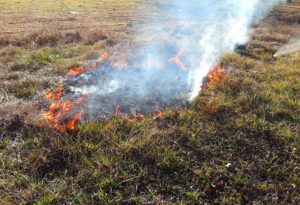The Wildflower Fire Experiment + What Is This Flower?
A couple of months ago, I was mulling over what to do with the long grasses which are covering the north part of my property. I know some of the clumps are non-native and invasive species, while the other grasses seemed to be thatched pretty heavily, not allowing anything to grow.
In addition, these grasses were not very attractive.
I thought maybe I could plow them up, sod bust them in a way, and plant a garden or, where the soil was too shallow, put down wildflower seeds. (we live on a limestone shelf, and in some places of the front yard, the shelf is exposed. Nearby, the soil is only an inch or so deep).
After doing some research (mostly on prarie grasses and wildflowers), I decided to take a lot of the tree limbs I’d trimmed from other parts of the yard, rake up the grass as best I could, and do controlled burns on the land.
The reason I decided to do a burn was simple: It replicates what happened on the prairie. Once the grass became very dense and thatched, eventually a lightening strike would happen, and a “prairie wildfire” would explode. Although these were large-scale events, they were known for two things:
- The grass that grew up afterwards was highly edible and prized by bison and other grazing animals, and
- The wildflower population EXPLODED in gorgeous and riotous colors.
I thought, maybe, by doing a similar, small scale burn on my grass space, and planting wildflowers afterwards, I could replicate that wildflower beauty.
The burns happened in January and February. In early March I raked several areas and scattered  mixes of wildflowers, including “Sunny Space Wildflower Mix” and “Bee and Bird Wildflower Mix” I’d purchased at the Dollar Store in December. The idea is:
mixes of wildflowers, including “Sunny Space Wildflower Mix” and “Bee and Bird Wildflower Mix” I’d purchased at the Dollar Store in December. The idea is:
- Burn
- Rake deep
- Scatter seed shallow
- Rake shallow (just enough to cover the seed lightly)
- Water / keep moist (As my wife’s nephew from next door watered, their dog danced around trying to get a drink. I decided this would be an experiment in “tamping down the seeds” as they were watered.)
EARLY RESULTS + WHAT ARE THESE WILDFLOWERS ?
?
 As you can see from the photos, the experiment is, thus far, successful. Although the grass is coming back slowly, more importantly is that there is a HUGE amount of small, white 6 lobed flowers on stalks between 3-5 inches long. I don’t know what they are, but they are definitely more attractive than the grass that was there before. See the closeup on the left.
As you can see from the photos, the experiment is, thus far, successful. Although the grass is coming back slowly, more importantly is that there is a HUGE amount of small, white 6 lobed flowers on stalks between 3-5 inches long. I don’t know what they are, but they are definitely more attractive than the grass that was there before. See the closeup on the left.
As you can tell from this distance photo, the wildflowers on the grass area are coming in, along with the grass. A second burn, to the top right in the photo, has not had anything grow back yet. That is where I threw a lot of the wildflower mix. Most importantly, though, at the top of the photo, where I did NOT burn, you can see the deep grass with no wildflowers at all. As a result, just based on the wildflowers, I’d say the experiement was a success.
NOTE: THIS WAS A VERY SMALL SCALE BURN, maybe about 30-100 square feet at a time. I also waited until conditions were right: No wind, high dew point, recent rain. In short, only the driest of the dead grass would burn really well.
I also waited until conditions were right: No wind, high dew point, recent rain. In short, only the driest of the dead grass would burn really well.
I also took precautions: I dug and raked “fire breaks”, so that when the fire hit soil or green grass, it would stop spreading. I also had several large buckets of water, a hose with the water turned on (in this photo, you can see the spray from the hose nozzle), and rakes and shovels.
If you are to do a larger burn, make certain you get a burn permit from your county fire marshall.